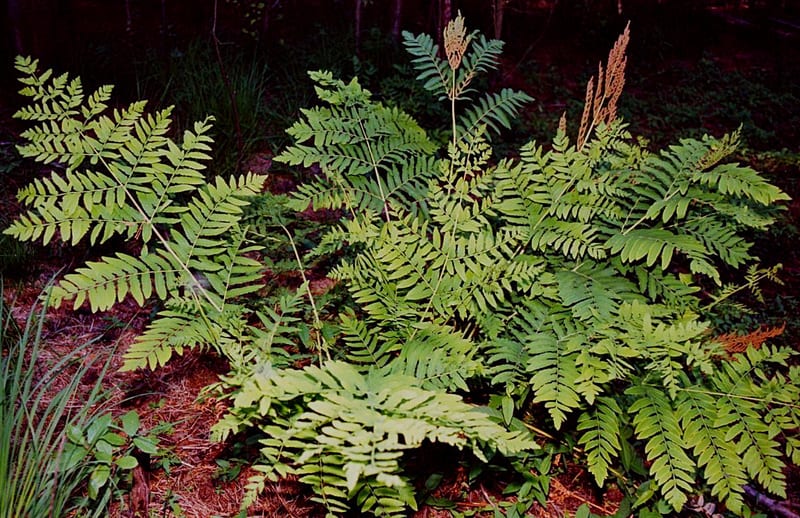
🌿 Morphology
🌞 Growing conditions
🌍 Origin and family
🌾 Uses
Warning: Despite the care taken in writing this sheet, it is essential to cross-reference sources before using or consuming any plant. When in doubt, consult a qualified professional
Permaculture uses
Royal Fern can be used in permaculture systems for its ornamental value, particularly in wet or boggy areas. While not typically consumed, some indigenous cultures have used the fiddleheads (young, curled fronds) in limited quantities after careful preparation to remove toxins. It is primarily valued for its aesthetic appeal and its ability to provide habitat for wildlife in wetland ecosystems. Its large size and distinctive appearance make it suitable as a focal point in shade gardens and alongside water features. There are no particularly well-known cultivars for permaculture use, but selecting varieties with attractive foliage can enhance the design.
Permapeople description
Osmunda regalis, commonly called royal fern, is a large deciduous fern found in temperate regions worldwide. It can grow up to 2 meters tall and has distinctive, bipinnate fronds. It prefers moist, shaded habitats.
Botanical description
Osmunda regalis, the Royal Fern, is a large deciduous fern with bipinnate fronds that can reach up to 6 feet in height. It features distinct fertile fronds that bear sporangia at the tips, resembling flowering structures, hence the name 'Flowering Fern.' The sterile fronds are deeply divided into broad pinnules, giving it a bold and textured appearance. The rhizomes are thick and creeping, contributing to its robust growth. The plant prefers wet, acidic soils and partial shade, often found in bogs, swamps, and damp woodlands. It is a long-lived perennial and can form substantial clumps over time. The plant is noted for its elegant appearance and its ability to thrive in challenging wet environments.
Companion planting
Royal Fern thrives in wet, acidic conditions and is typically found in areas where few other plants can survive. It is well-suited to growing alongside other moisture-loving plants such as bog plants, sedges, and moisture tolerant trees like alder or willow. Avoid planting near alkaline-loving plants or those that prefer dry conditions, as they will not thrive in the same environment. Its presence can benefit the surrounding area by providing shade and helping to retain moisture in the soil.
Propagation methods
Royal Fern can be propagated by spore collection and sowing, though this method is slow and requires specialized knowledge. More commonly, it is propagated by division of the rhizomes in early spring or fall. Carefully separate the rhizomes, ensuring each division has healthy roots and fronds. Plant the divisions in moist, acidic soil. Seed propagation is difficult and not often practiced.
History and traditions
Historically, Royal Fern has been used medicinally in various cultures. In some traditions, it was believed to have wound-healing properties and was used topically for burns and skin ailments. The rhizomes have also been used as a source of starch in times of food scarcity, though this is not a primary traditional use. The fern's imposing size and regal appearance have also led to its association with royalty and prestige in some cultures, hence the name 'Royal Fern.' Some indigenous cultures also used it for basketry.
Usage calendar
Spores are released in late spring to early summer (May-June). Rhizome division is best done in early spring (March-April) or fall (September-October). New fronds emerge in spring (April-May). The plant exhibits its full growth during the summer months (June-August). Fronds die back in the fall (October-November). Pruning dead or damaged fronds can be done at any time of year.
